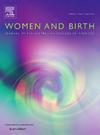Informed, supported, confident: A realist evaluation of The Birth Map
IF 4.1
2区 医学
Q1 NURSING
引用次数: 0
Abstract
Problem
Birth preparation needs a standardised, communication-focused, structured and collaborative approach that acknowledges women as decision makers.
Background
The Birth Map is a consumer-driven, woman-led, structured approach to birth preparation in the form of a book.
Aim
To evaluate The Birth Map from the perspective of women across different models of care within Australian maternity services.
Methods
Realist Evaluation methodology, with 32 self-selected participants from various models of care who gave birth from September to December 2022 throughout Australia. Participants provided reflections of their experiences throughout pregnancy from March to December 2022, and 12 were interviewed postpartum in January and February 2023. Transcriptions of reflections and interviews were coded for context, mechanism and outcomes.
Findings
Women saw themselves as decision makers and used The Birth Map to help make sense of their options and to communicate their needs to their care team. Reports were positive across communication, experience and decision making. Communication barriers included short appointment times and dismissive care providers, which impacted the experience negatively and impeded decision making.
Discussion
Maternal Decision Making is a process of balancing information and individual circumstances. Women use a process of sensemaking to build support and confidence for decision making. Supported Maternal Decision Making is crucial to a Respectful Maternity Experience. Whilst The Birth Map was a mitigating factor to the identified barriers, care provider training is recommended.
Conclusion
The structured, woman-led approach to birth preparation supports effective communication in maternity services through sensemaking, relationship building and supported maternal decision making.
知情、支持、自信:对《出生地图》的现实主义评价
问题生育准备需要一种标准化的、注重沟通的、结构化的和协作的方法,这种方法承认妇女是决策者。《出生地图》是以一本书的形式,以消费者为导向,以女性为主导,以结构化的方法来准备生育。目的从妇女的角度评估澳大利亚产妇服务中不同护理模式的生育地图。方法采用现实主义评价方法,选取32名来自澳大利亚各地不同护理模式的产妇,于2022年9月至12月分娩。参与者反映了她们在2022年3月至12月期间的怀孕经历,其中12人在2023年1月和2月接受了产后采访。反思和访谈的转录被编码为背景,机制和结果。研究发现女性将自己视为决策者,她们使用“出生地图”来帮助了解自己的选择,并将自己的需求传达给护理团队。报告在沟通、经验和决策方面都是积极的。沟通障碍包括预约时间短和护理提供者不屑一顾,这对体验产生了负面影响,阻碍了决策。母亲的决策是一个平衡信息和个人情况的过程。女性通过意义建构的过程来为决策建立支持和信心。支持产妇决策是尊重产妇经验的关键。虽然《出生地图》是减轻已确定障碍的一个因素,但建议对护理人员进行培训。结论结构化的、以妇女为主导的分娩准备方法通过意义构建、关系建立和支持产妇决策,支持产妇服务中的有效沟通。
本文章由计算机程序翻译,如有差异,请以英文原文为准。
求助全文
约1分钟内获得全文
求助全文
来源期刊

Women and Birth
NURSING-OBSTETRICS & GYNECOLOGY
CiteScore
7.20
自引率
13.20%
发文量
371
审稿时长
27 days
期刊介绍:
Women and Birth is the official journal of the Australian College of Midwives (ACM). It is a midwifery journal that publishes on all matters that affect women and birth, from pre-conceptual counselling, through pregnancy, birth, and the first six weeks postnatal. All papers accepted will draw from and contribute to the relevant contemporary research, policy and/or theoretical literature. We seek research papers, quality assurances papers (with ethical approval) discussion papers, clinical practice papers, case studies and original literature reviews.
Our women-centred focus is inclusive of the family, fetus and newborn, both well and sick, and covers both healthy and complex pregnancies and births. The journal seeks papers that take a woman-centred focus on maternity services, epidemiology, primary health care, reproductive psycho/physiology, midwifery practice, theory, research, education, management and leadership. We also seek relevant papers on maternal mental health and neonatal well-being, natural and complementary therapies, local, national and international policy, management, politics, economics and societal and cultural issues as they affect childbearing women and their families. Topics may include, where appropriate, neonatal care, child and family health, women’s health, related to pregnancy, birth and the postpartum, including lactation. Interprofessional papers relevant to midwifery are welcome. Articles are double blind peer-reviewed, primarily by experts in the field of the submitted work.
 求助内容:
求助内容: 应助结果提醒方式:
应助结果提醒方式:


